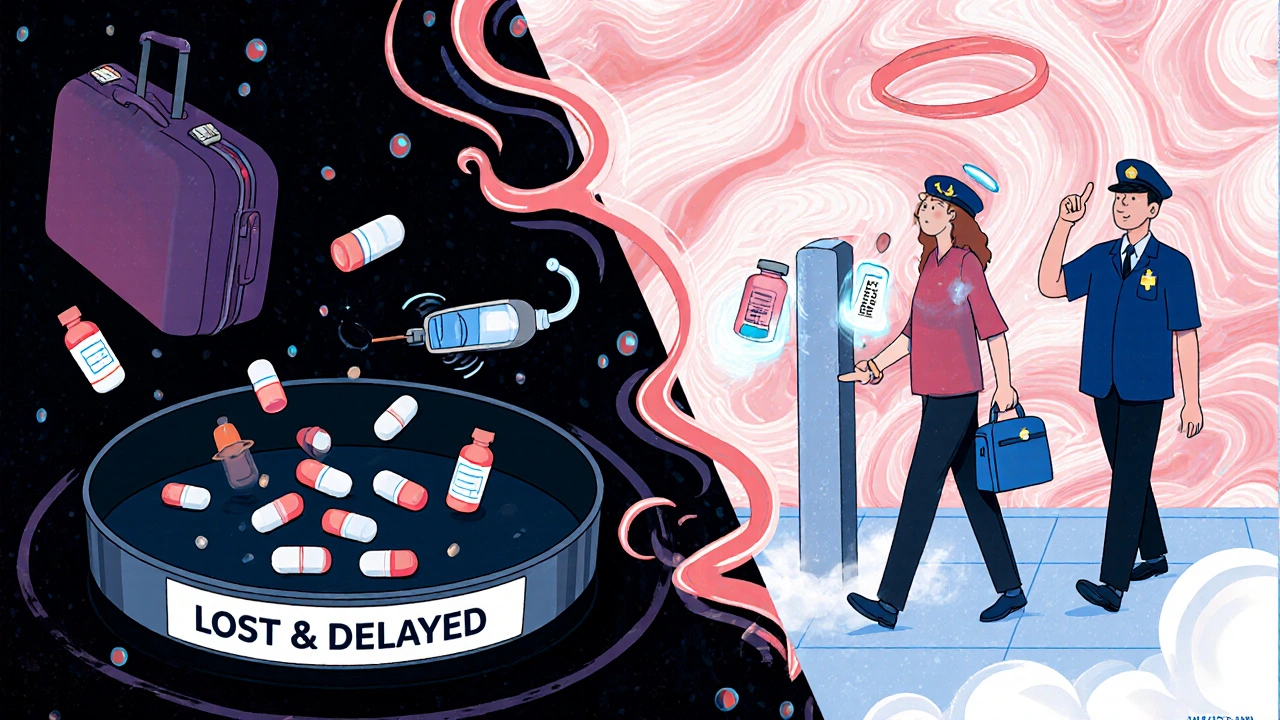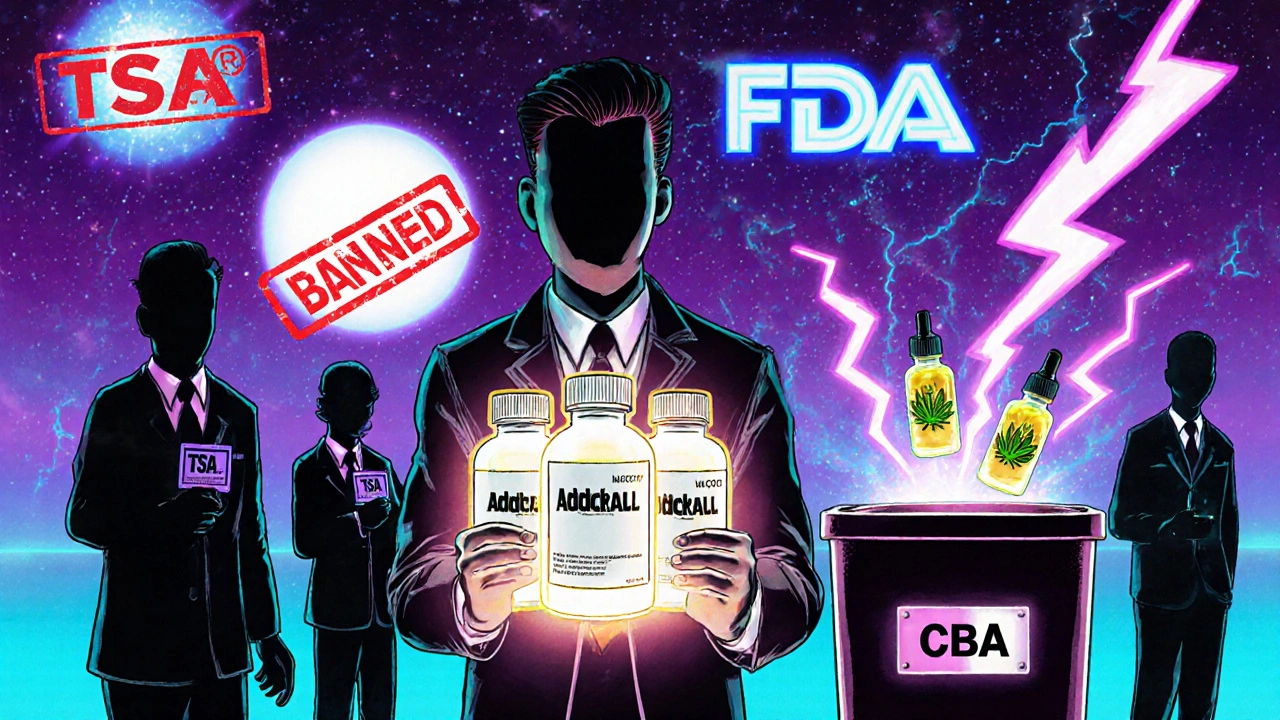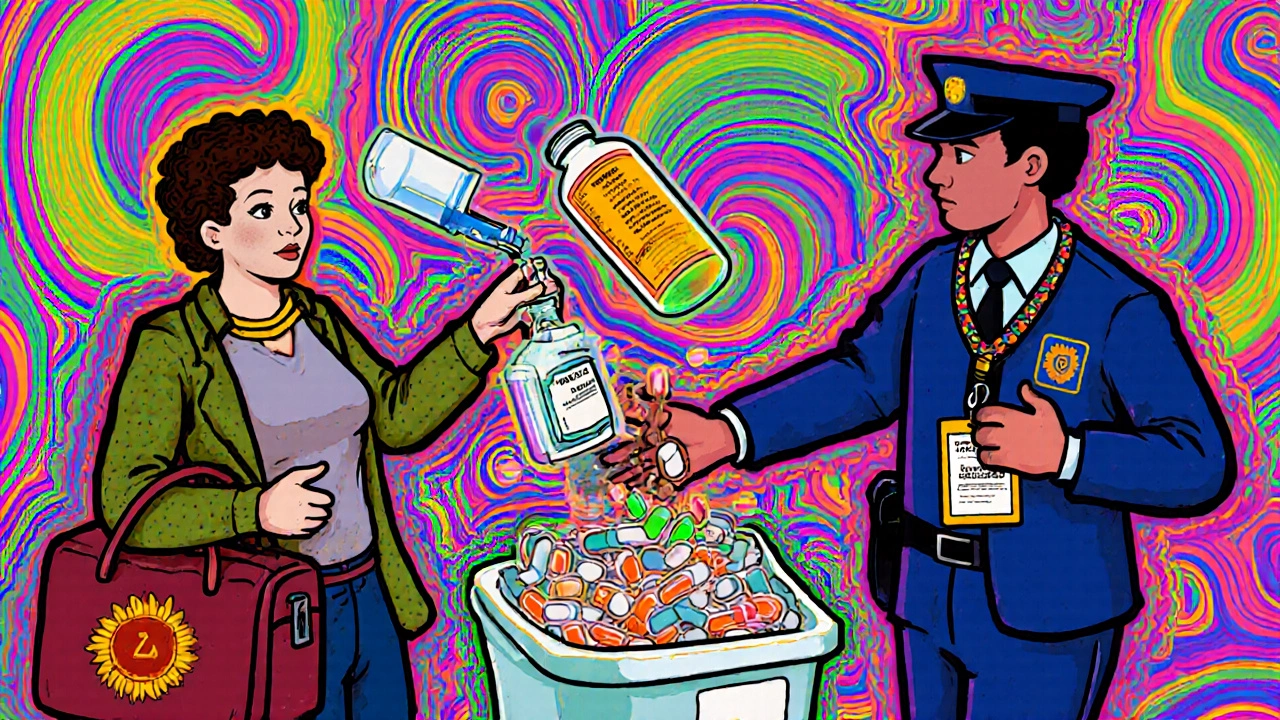Traveling with prescription medications shouldn’t be a headache-but too many people find themselves stuck at security because they didn’t know the rules. Whether you’re carrying insulin, anxiety meds, pain relievers, or even topical creams, the TSA guidelines for flying with prescription medications are clearer than most people think. But they’re also full of traps that can delay your flight or even lead to confiscated medicine. Here’s exactly what you need to do-no guesswork, no myths, just the facts as they stand in late 2025.
You Can Bring Any Amount of Prescription Medicine
The biggest myth? That you’re limited to 3.4 ounces of liquid meds like everyone else. That’s not true. The TSA allows unlimited quantities of prescription medications in any form: pills, liquids, gels, creams, inhalers, or injections. Insulin pens? No limit. Liquid painkillers? Bring your whole bottle. Eczema cream? Go ahead. None of it has to fit in your quart-sized bag.
This exemption exists because the TSA recognizes that people with chronic conditions can’t just cut their doses to fit airline rules. If you’re on daily medication, your health comes first. The agency doesn’t care how much you have-as long as it’s real and prescribed to you.
Don’t Put Medication in Checked Luggage
Never. Ever. Put your pills, liquids, or medical devices in checked bags. This isn’t just a suggestion-it’s a hard rule from every major U.S. airline, including United, Delta, and American. Why? Because bags get lost, delayed, or damaged. And if your life-saving insulin or heart medication disappears, you’re stuck.
There are real cases of people arriving at their destination with no meds because their bag was rerouted. One traveler with Type 1 diabetes had her entire insulin supply in checked luggage. It didn’t make the flight. She ended up in the ER. Don’t be that person.
Keep everything in your carry-on. Even if you don’t plan to use it during the flight, keep it with you. If you’re flying internationally, this is even more critical-some countries won’t let you import meds without proof they’re in your possession upon arrival.
Original Packaging? Not Required, But Highly Recommended
TSA doesn’t legally require your meds to be in original bottles. But here’s the catch: if you take them out of the bottle and dump them into a pill organizer or a small plastic bag, you’re making things harder for yourself.
Why? Because TSA officers need to verify what you’re carrying. If you have 20 unlabeled pills, they’ll ask for proof it’s yours. That means showing your ID and matching the name on the prescription. If your name is “Robert J. Smith” and the bottle says “Bob Smith,” that’s enough. But if the bottle is gone and you just have a bag of pills? You’re going to wait while they call a supervisor. That’s 5-10 extra minutes you don’t need.
Doctors and pharmacists often recommend keeping meds in original containers because they include the pharmacy label, your name, the drug name, dosage, and prescriber info. That’s your best defense against delays. If you’re worried about bulk, transfer only what you need for the trip into a small container-but keep the original bottle with you, too.
Declare Liquid Medications at Security
Even though you can bring unlimited liquids, you still have to tell TSA about them. Don’t just toss them in your bag and walk through. At the checkpoint, take your meds out of your carry-on and place them in a separate bin. Say something like, “I have liquid medication here.”
They won’t always ask for documentation-but if they do, be ready. Bring your ID and, if possible, a copy of your prescription or a doctor’s note. Especially if you’re carrying injectables, large volumes, or anything that looks unusual. A simple note from your doctor saying “Patient requires daily insulin injections” can save you from a long wait.

CBD Oil and Marijuana Are Still a No-Go
This is where things get messy. Even if you have a legal prescription for CBD oil in your state, and even if the label says it contains less than 0.3% THC, TSA can still confiscate it. Why? Because marijuana is still illegal under federal law-and TSA follows federal rules, not state ones.
In 2023, over 14,000 CBD products were confiscated by TSA despite being legally compliant. Many of those were later returned after review, but that doesn’t help you when you’re missing your flight. The safest move? Leave it at home. If you need it for anxiety, pain, or sleep, find an alternative that’s federally legal-like melatonin, magnesium, or prescription sleep aids.
And never, ever try to sneak in marijuana, weed, or THC gummies. Even in small amounts. You’re not just risking a delay-you’re risking a federal offense.
Controlled Substances Like Adderall or Xanax Are Risky Abroad
If you’re flying internationally, the rules change completely. Medications that are perfectly legal in the U.S. can be completely banned in other countries. Adderall? Illegal in Japan and the UAE. Xanax? Banned in South Korea. Tramadol? Restricted in Germany. Even over-the-counter cold medicine with pseudoephedrine can get you arrested in some places.
Before you leave, check the destination country’s rules. The CDC’s Yellow Book and the International Association for Medical Assistance to Travellers (IAMAT) have databases that list restricted drugs by country. You can also call the embassy of your destination country and ask. Don’t assume your prescription is enough. You need to know if the country allows it at all.
For controlled substances, carry a letter from your doctor explaining why you need it, the dosage, and the duration of your trip. Some countries require a special permit-get it before you fly.
Medical Devices Like Insulin Pumps and CGMs Are Allowed
If you use an insulin pump, continuous glucose monitor (CGM), or other medical device, you can bring it through security. TSA allows you to request a visual inspection instead of putting it through the X-ray machine. You don’t need to remove it from your body.
But here’s what most people don’t do: tell the officer before you go through. Say, “I have a medical device.” That way, they know to handle it carefully. If you’re nervous, you can also request a private screening.
For devices that need cooling-like insulin-you can bring frozen gel packs as long as they’re completely frozen solid. Once they start melting, they’ll be treated like liquids. So pack them in a cooler with ice, and keep them sealed until you’re at the checkpoint.
TSA PreCheck Makes This Easier
If you’re a TSA PreCheck member (and you should be), you’re in luck. You don’t have to take out your liquids, laptops, or medications during screening. That means your insulin, pills, and creams can stay in your bag. You just walk through like normal.
As of late 2024, over 28 million people are enrolled in PreCheck. It costs $78 for five years and takes about 10 minutes to apply. If you fly even once a year, it’s worth it-not just for meds, but for the whole process.

Use the Sunflower Lanyard If You Need Extra Help
If you have a hidden disability-like diabetes, anxiety, autism, or chronic pain-you can ask for a Sunflower Lanyard at the checkpoint. It’s a discreet way to signal to TSA officers that you might need more time, a quieter space, or help communicating.
The program is now active in 45 major U.S. airports. Just ask at the screening area. No paperwork needed. No explanation required. They’ll guide you through the process.
What If Your Meds Get Confiscated?
If TSA takes your medication, they’ll give you a receipt and instructions on how to file a claim. Most of the time, especially with compliant prescriptions, they’ll return it within a few days. But don’t count on it.
For CBD or controlled substances, the chances of getting it back are slim. That’s why prevention matters. Know the rules. Pack smart. Declare everything. Don’t gamble with your health.
International Travel? Bring No More Than a 90-Day Supply
Customs and Border Protection (CBP) recommends travelers bring no more than a 90-day supply of medication into the U.S. If you’re staying longer, you’ll need a letter from your doctor explaining why. That’s especially true for controlled substances.
Same goes for leaving the U.S. If you’re taking meds abroad for more than three months, check if your destination requires an import permit. Some countries will let you bring in a year’s supply with proper documentation. Others won’t let you bring any.
Always carry a copy of your prescription in English-and if possible, translated into the local language. A pharmacy printout with the doctor’s signature is better than a digital photo.
Final Checklist Before You Fly
- Keep all medications in your carry-on
- Use original bottles with pharmacy labels when possible
- Bring a doctor’s note for injectables or controlled substances
- Declare liquids at the checkpoint
- Leave CBD oil and marijuana at home
- Check destination country’s medication rules
- Use TSA PreCheck if you have it
- Ask for a Sunflower Lanyard if you need extra support
- Don’t transfer meds into unlabeled containers
- Bring no more than a 90-day supply for international trips
Traveling with medication is easier than it looks-if you plan ahead. The TSA isn’t out to hassle you. They just need to make sure what you’re carrying is safe and legal. Do your part, and you’ll breeze through security without a second thought.

Asha Jijen
November 27, 2025 AT 01:21Why do they even make this so complicated just to carry pills
Just let us bring what we need no one cares
Lauren Zableckis
November 27, 2025 AT 19:18I’ve been flying with insulin for 12 years and this guide is spot on. Original bottles saved me twice when officers questioned my vials. Never skip the doctor’s note-even if you think it’s overkill. It’s not bureaucracy, it’s insurance for your health.
Gayle Jenkins
November 27, 2025 AT 20:13For anyone nervous about security: just say ‘I have medication’ clearly and hand over your prescription or note before they even ask. Most officers appreciate the heads-up. I used to panic until I realized they’re just doing their job-not trying to ruin your trip. Be calm, be clear, be prepared. It’s that simple.
Kaleigh Scroger
November 28, 2025 AT 03:27People don’t realize how dangerous it is to repack meds into pill organizers without keeping the original bottle. I once saw a guy get detained because he had 30 unlabeled pills in a ziplock. He swore they were his anxiety meds but had no label, no script, nothing. TSA had to call in a pharmacist just to verify. Took 45 minutes. He missed his flight. Don’t be that guy. Keep the bottle. Even if it’s ugly. Even if it’s bulky. It’s not about convenience-it’s about not ending up in a hospital overseas because you were lazy.
Darrel Smith
November 28, 2025 AT 09:12Let me be perfectly clear: if you bring CBD oil on a plane, you’re not just being reckless-you’re being selfish. You think you’re just trying to relax, but you’re risking a federal investigation for everyone else in line. You’re making security’s job harder. You’re making it harder for people who actually need insulin or heart meds to get through without delays. This isn’t about freedom-it’s about responsibility. And if you can’t handle that, then stay home.
reshmi mahi
November 28, 2025 AT 09:18USA thinks it runs the world lol
My country bans Adderall but you guys act like it’s a grocery item
Go check your own house before lecturing everyone else 😂
laura lauraa
November 30, 2025 AT 03:44It’s fascinating, isn’t it? How the state, under the guise of ‘safety,’ imposes bureaucratic rituals upon the medically vulnerable-while simultaneously failing to protect them from the very systems that commodify their suffering. The Sunflower Lanyard? A performative gesture. A Band-Aid on a hemorrhage. The real issue is that our society has normalized the criminalization of bodily autonomy under the banner of ‘national security.’ And yet, we are told to be grateful for the crumbs of accommodation. This isn’t guidance-it’s gaslighting dressed as helpful advice.
Elizabeth Choi
December 1, 2025 AT 08:24Interesting how the article says ‘TSA doesn’t require original packaging’ but then spends 3 paragraphs pressuring you to use it anyway. That’s not guidance-that’s coercion disguised as helpfulness. Also, the 90-day limit for international travel? Arbitrary. Why 90? Why not 120? Why not 180? No evidence cited. Just ‘CBP recommends.’ That’s not policy-that’s opinion masquerading as authority.
Edward Batchelder
December 2, 2025 AT 11:41To everyone reading this: thank you for sharing this. Seriously. I’ve seen too many people stressed out at security because they didn’t know the rules. And I’ve seen TSA officers get frustrated because travelers don’t know how to communicate their needs. This guide? It’s not just helpful-it’s kind. It bridges a gap. If you’re traveling with medication, you’re not a burden. You’re a person. And this? This is how we take care of each other. Share this with your friends. Print it. Save it. Pass it on. We’re all in this together.